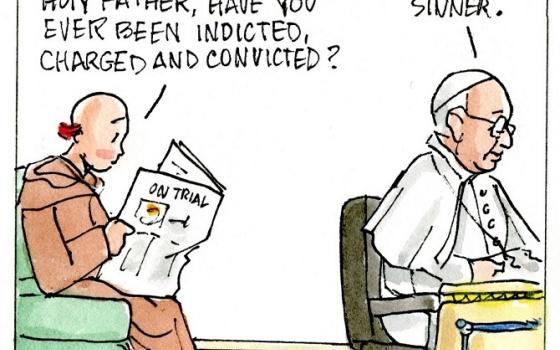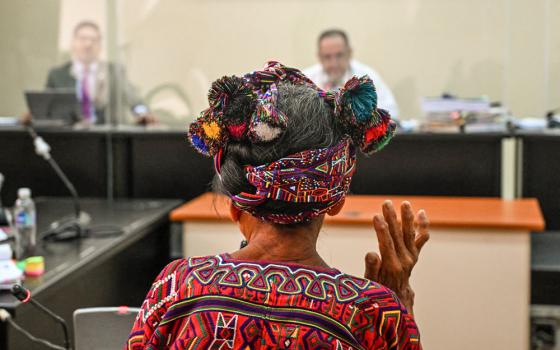By JOHN L. ALLEN JR.
Here’s something you don’t see every day: A prominent Catholic leader in Italy has drawn a nasty personal attack, described as “disgusting” by the president of the Italian bishops’ conference, from a newspaper owned by the country’s conservative prime minister. It’s a situation that defies the usual political dynamics in European nations, particularly Italy, where these spats typically pit the church against the secular left.
One prominent Italian commentator and political scientist has suggested that the affair illustrates a profound "mutation" in church/state relations, rendering the old battles between Catholics and secularists largely irrelevant. Today, he said, the real fault line runs between those who support an institutional role for the church as a voice of conscience and those who don't -- with many secularists and Catholics, liberals and conservatives, falling on both sides of that divide.
In the background is the recent soap opera around conservative Prime Minister Silvio Berlusconi, a 72-year-old real estate and media tycoon, who’s also known as something of a lothario. For some time he’s been estranged from his second wife, former actress Veronica Lario, and earlier this year Lario announced she was seeking a divorce due to what she called Berlusconi’s “infatuation” with young women. Allegations include that women were paid to attend parties at his Sardinian villa, while a high-class prostitute said she spent a night with him at his Rome residence.
In general, Italy’s Catholic bishops have stayed out of the public to-and-fro surrounding Berlusconi’s private life. Not so their daily newspaper, however, L’Avvenire, which has taken a strong line suggesting that the prime minister’s behavior has set a poor moral tone.
On Friday, the conservative Italian daily Il Giornale, part of Berlusconi’s media empire, fired back. It ran a blistering front-page attack on L’Avvenire’s editor, Catholic layman Dino Boffo, titled “The super-moralist condemned for molestations.” Based on events that allegedly took place in 2001/2002, Il Giornale suggested that Boffo, whom it described as a “known homosexual,” had been charged by Italian prosecutors for harassing a woman in Terni because he wanted to pursue an affair with her husband.
In support of that claim, the paper published a court document which appeared to show that Boffo was fined some $800 for the episode. The document, which reportedly has been mailed anonymously to all the country’s bishops, asserted that Cardinal Camillo Ruini, the powerful former vicar of Rome and former president of the bishops’ conference, as well as Cardinal Diogini Tettamanzi of Milan and Archbishop Giuseppe Betori of Florence, “were without doubt aware of the offense.”
Boffo published a response Monday morning suggesting, in substance, that the document is a fake. Public officials have so far declined comment, leaving the precise details of what, if anything, transpired in Terni with regard to Boff vague.
For the record, Berlusconi has denied having anything to do with Il Giornale’s decision to publish the material.
Over the weekend, Cardinal Angelo Bagnasco of Genova, president of the bishops’ conference, called the attack on Boffo “disgusting” and “very serious.”
“I renew to Dr. Boffo … all of my esteem and my personal trust, as well as that of the Italian bishops and of all Christian communities,” Bagnasco said. Betori described the accusations against Boffo as “worthy of the trash can.”
One bit of fallout came Friday, when the Vatican cancelled a planned dinner between Berlusconi and Cardinal Tarcisio Bertone, the Vatican’s secretary of state. Things became even more surreal when the legendarily irascible Italian politician Umberto Bossi, head of the far-right Northern League and a figure known over the years for occasional anti-clerical outbursts, said he would take it upon himself to try to heal the rift between the governing center-right coalition and the Vatican.
On Sunday, veteran Italian commentator Ernesto Galli della Loggia, a self-described atheist who is nonetheless friendly to the church, published an essay in Corriere della Sera, Italy’s leading daily. He suggested that beyond the tawdry theatrics, this episode illustrates a deep “mutation” in church/state relations. The following is an NCR translation of Galli della Loggia’s essay.
Those Distances from the Church
Corriere della Sera, Sunday, August 30, 2009, Page 1
By ERNESTO GALLI DELLA LOGGIA
The white-hot conflict seen in these days between the Catholic hierarchy and the center-right is certainly a new twist in post-war Italy. It’s not something to be under-estimated, even if it’s likely that in fairly short order the spat will be patched up, since neither party has an interest in a rupture.
One substantial point emerges with great clarity: There’s a mutation in public opinion regarding relations between church and state, with everything that means and everything it includes. It’s a deep mutation, a turning point that will begin to make its weight felt more and more.
The mutation I’m talking about has one towering effect: That of rendering the old antagonism between secularists and Catholics progressively irrelevant.
A long phase of Italian history was marked by this antagonism. It had its epicenter in periodic disputes over the legislation of the state in certain “sensitive” areas, such as education, matrimony, and so on, but it was kept under control, so to speak, by a strong national consensus on one decisive point: recognition of the inescapably institutional character of the Catholic church. This consensus implied that, in order to carry out its mission, the church needed a total and full autonomy that in practice could be assured only by sovereignty in its own sphere of affairs, as well as adequate instruments (including financing) to project its presence and voice in society.
That widely accepted consensus has been the basis in the decades since the war for the more or less unanimous acceptance of the Concordat as the regulative instrument for relations between church and state. At its base, the issue isn’t the objective “liberty” of the church, since to protect that all you’d need is any democratic constitution. It’s a matter of “sovereignty,” so that the church feels “free” only when, in some sense, it’s also “sovereign.”
What’s mutating right now (and falling apart) is precisely the nearly unanimous consensus I’ve been describing. Instead, the idea that the church doesn’t need a strong institutional profile is gaining ground, both among believers and non-believers.
The former take this view out of a renewed dream of a faith capable of living and expressing itself in the world solely through the force of the Spirit and the Word, not to mention the ever-present fear of contaminating the church’s high principles through the misery of reality.
Among the latter, however, a conviction is spreading – previously held by very few secularists – that an institutionalized and “sovereign” church, and thus the Concordat which recognizes such a church, not only represents an attack upon the equality of all citizens and upon the exercise of an ever more vast and subjectively oriented sphere of rights, but also an unmerited presence of religion in public life.
Thus the key distinction now runs along these lines: No longer between “secularists” and “Catholics,” but between those who are favorable and those who are against recognition of the church as a national institution which merits social space.
That implies a complete disruption of the old alliances. Just as believers and non-believers can happily find themselves on the same side, against an official church considered “authoritarian” and stuck on its temporal power, the very same thing can happen on the other side. Even non-believers may consider religion a precious contribution to our collective identity, and to the definition of the values at the basis of our society.




